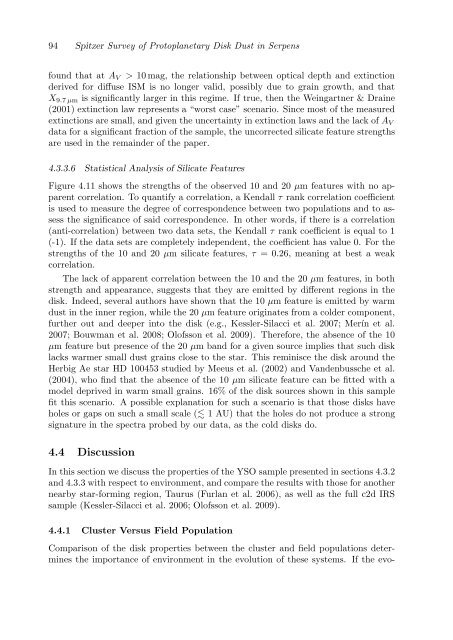Observational Constraints on The Evolution of Dust in ...
Observational Constraints on The Evolution of Dust in ...
Observational Constraints on The Evolution of Dust in ...
Create successful ePaper yourself
Turn your PDF publications into a flip-book with our unique Google optimized e-Paper software.
94 Spitzer Survey <strong>of</strong> Protoplanetary Disk <strong>Dust</strong> <strong>in</strong> Serpens<br />
found that at A V > 10 mag, the relati<strong>on</strong>ship between optical depth and ext<strong>in</strong>cti<strong>on</strong><br />
derived for diffuse ISM is no l<strong>on</strong>ger valid, possibly due to gra<strong>in</strong> growth, and that<br />
X 9.7 µm is significantly larger <strong>in</strong> this regime. If true, then the We<strong>in</strong>gartner & Dra<strong>in</strong>e<br />
(2001) ext<strong>in</strong>cti<strong>on</strong> law represents a “worst case” scenario. S<strong>in</strong>ce most <strong>of</strong> the measured<br />
ext<strong>in</strong>cti<strong>on</strong>s are small, and given the uncerta<strong>in</strong>ty <strong>in</strong> ext<strong>in</strong>cti<strong>on</strong> laws and the lack <strong>of</strong> A V<br />
data for a significant fracti<strong>on</strong> <strong>of</strong> the sample, the uncorrected silicate feature strengths<br />
are used <strong>in</strong> the rema<strong>in</strong>der <strong>of</strong> the paper.<br />
4.3.3.6 Statistical Analysis <strong>of</strong> Silicate Features<br />
Figure 4.11 shows the strengths <strong>of</strong> the observed 10 and 20 µm features with no apparent<br />
correlati<strong>on</strong>. To quantify a correlati<strong>on</strong>, a Kendall τ rank correlati<strong>on</strong> coefficient<br />
is used to measure the degree <strong>of</strong> corresp<strong>on</strong>dence between two populati<strong>on</strong>s and to assess<br />
the significance <strong>of</strong> said corresp<strong>on</strong>dence. In other words, if there is a correlati<strong>on</strong><br />
(anti-correlati<strong>on</strong>) between two data sets, the Kendall τ rank coefficient is equal to 1<br />
(-1). If the data sets are completely <strong>in</strong>dependent, the coefficient has value 0. For the<br />
strengths <strong>of</strong> the 10 and 20 µm silicate features, τ = 0.26, mean<strong>in</strong>g at best a weak<br />
correlati<strong>on</strong>.<br />
<strong>The</strong> lack <strong>of</strong> apparent correlati<strong>on</strong> between the 10 and the 20 µm features, <strong>in</strong> both<br />
strength and appearance, suggests that they are emitted by different regi<strong>on</strong>s <strong>in</strong> the<br />
disk. Indeed, several authors have shown that the 10 µm feature is emitted by warm<br />
dust <strong>in</strong> the <strong>in</strong>ner regi<strong>on</strong>, while the 20 µm feature orig<strong>in</strong>ates from a colder comp<strong>on</strong>ent,<br />
further out and deeper <strong>in</strong>to the disk (e.g., Kessler-Silacci et al. 2007; Merín et al.<br />
2007; Bouwman et al. 2008; Ol<strong>of</strong>ss<strong>on</strong> et al. 2009). <strong>The</strong>refore, the absence <strong>of</strong> the 10<br />
µm feature but presence <strong>of</strong> the 20 µm band for a given source implies that such disk<br />
lacks warmer small dust gra<strong>in</strong>s close to the star. This rem<strong>in</strong>isce the disk around the<br />
Herbig Ae star HD 100453 studied by Meeus et al. (2002) and Vandenbussche et al.<br />
(2004), who f<strong>in</strong>d that the absence <strong>of</strong> the 10 µm silicate feature can be fitted with a<br />
model deprived <strong>in</strong> warm small gra<strong>in</strong>s. 16% <strong>of</strong> the disk sources shown <strong>in</strong> this sample<br />
fit this scenario. A possible explanati<strong>on</strong> for such a scenario is that those disks have<br />
holes or gaps <strong>on</strong> such a small scale ( 1 AU) that the holes do not produce a str<strong>on</strong>g<br />
signature <strong>in</strong> the spectra probed by our data, as the cold disks do.<br />
4.4 Discussi<strong>on</strong><br />
In this secti<strong>on</strong> we discuss the properties <strong>of</strong> the YSO sample presented <strong>in</strong> secti<strong>on</strong>s 4.3.2<br />
and 4.3.3 with respect to envir<strong>on</strong>ment, and compare the results with those for another<br />
nearby star-form<strong>in</strong>g regi<strong>on</strong>, Taurus (Furlan et al. 2006), as well as the full c2d IRS<br />
sample (Kessler-Silacci et al. 2006; Ol<strong>of</strong>ss<strong>on</strong> et al. 2009).<br />
4.4.1 Cluster Versus Field Populati<strong>on</strong><br />
Comparis<strong>on</strong> <strong>of</strong> the disk properties between the cluster and field populati<strong>on</strong>s determ<strong>in</strong>es<br />
the importance <strong>of</strong> envir<strong>on</strong>ment <strong>in</strong> the evoluti<strong>on</strong> <strong>of</strong> these systems. If the evo-
















